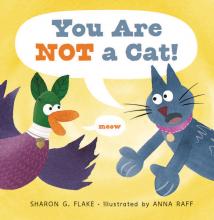 |
| Photo from BoydMillsPress.com |
In the best tradition of silly impersonation tales, You Are NOT a Cat takes us along as Duck
and Cat debate the propriety of Duck’s expressions of identity. With clear
comparisons to be made with the 2013 Elephant and Piggie series title I Am a Frog, this humorous read aloud
prompts a second look for beginning readers.
The text of the book is set against white word bubbles,
carving space out of the full bleed ink wash, pen, and pencil drawings. The
text is a reasonable size for a beginning reader, the lines are short –
generally 3-7 words - and feature sight words. The nature of the debate lends
itself to some repetition – there are quite a few quacks and meows.
As a picture book, You Are NOT a Cat contains direct and
humorous illustrations. Duck’s leaf “ears” on the cover are a nice touch, and I
enjoy Duck’s parrot imitation. But looking at the criteria, the presence of
illustrations is insufficient – these illustrations must “demonstrate the story
being told” and “function as keys or clues to the text”. The very plot rests on
the tension between what is observably true – that Duck is a duck – and what is
being stated – that he is a cat. But this kind of tension does not necessarily
serve our beginning reader well. Instead of providing a clue to our reader, the
illustrations are often directly contradicting what is being stated, starting
on the very first page when Duck declares himself a cat.
But wait – you might say – wait just a moment, “cat” is a
three-letter word, a sight word, and there IS a cat on the page, after all.
Aren’t we being a bit harsh?
Let’s read on, I would reply. Because on the page describing
a “long, straight tail” there is none present. Which is the entire point, of course.
And while there are “whiskers” on the following page, just how well is the
illustration providing clues to “tickle the air”? None of those new words will
be repeated anywhere in the story. Similarly, “makes nice music” and “parrot” and “rooster”and “cock-a-doodle-doo” go relatively unrepresented. To be fair Duck IS imitating a
rooster when he uses those last two words, so were I on the committee I would defer to the beginners reads I was
observing to see if Duck’s imitation is a sufficient clue for them. None of these things detract from the story’s humor or
effectiveness as a read aloud, of course. But when evaluating it using the
Geisel criteria, we must consider how the illustrations support the successful
reading experience.
Similarly, the criteria state that “sentences must be simple
and straightforward”. The presence of so many questions - “Now you’re a parrot,
I suppose?” and “And tomorrow?” for example, may challenge the comprehension of
our beginning reader. A beginning reader may struggle to read these questions
with the appropriate expression, as they will not perceive the question mark
until they’ve reached the end of the sentence. The committee would need to determine
if the ten question marks in this story impact the successful experience of the
beginning reader.
Despite several elements supportive of the beginning reader, the effectiveness of the illustrations as clues to the text would hold me back from supporting You Are NOT a Cat! at the Geisel table. But I would only be one of seven votes - would it have a place on your ballot?

Thanks for covering this book, Amanda. I agree, there's a lot in this book that might take it off the table for the Geisel Committee. However, I'd like to put forth this title for "best beginning reader font" award of the year. It especially shines when it comes to those "a's" and "g's." :)
ReplyDelete